Starbucks vs. Dunkin Donuts, a Study in Social Media Audience Contrasts — Part 1
Starbucks vs. Dunkin Donuts, a Study in Social Media Audience Contrasts — Part 1
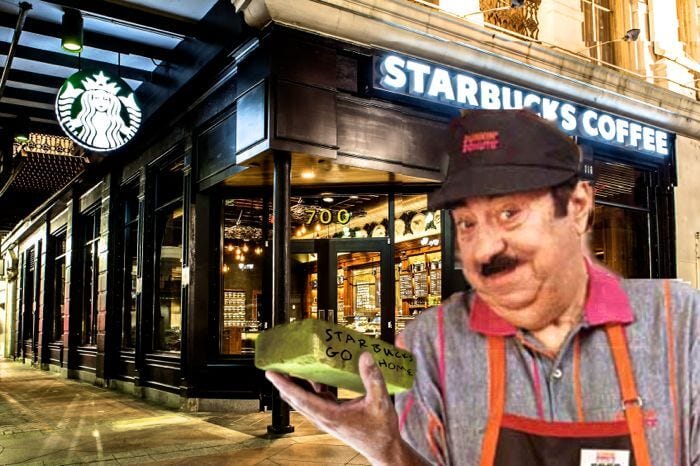
With this entry we are comparing Starbucks with Dunkin’ Donuts .
We’ve learned some things doing this study. Despite the fact that they sell, more or less, the exact same products, the conflicting experiences of patronizing either of these two chains — already quite pronounced in the minds of most consumers — is nothing next to the differences in the companies themselves.
Let’s get things started with a chart, and stats, and all that stuff we’re really here to do.
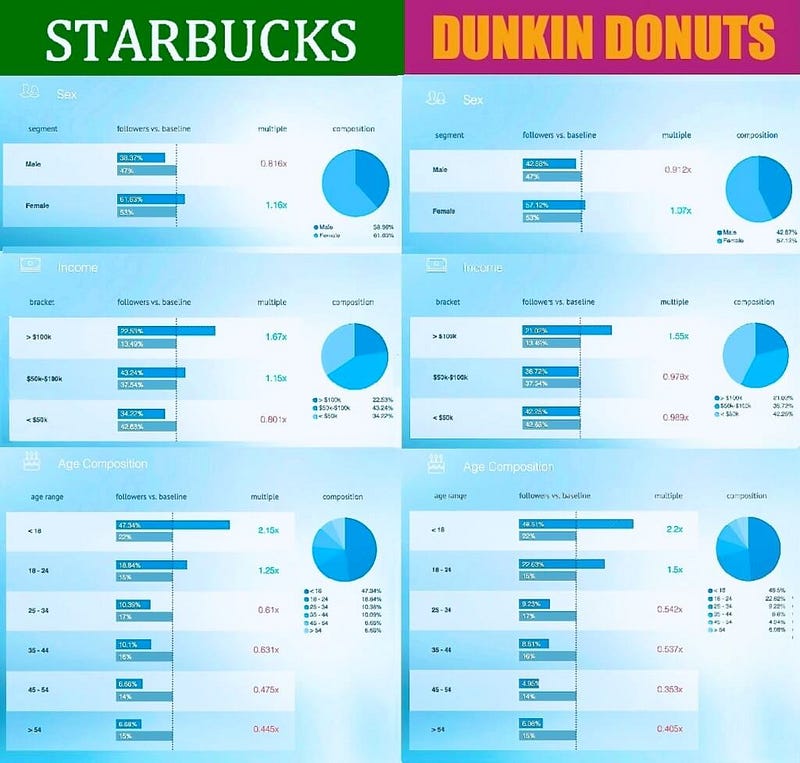
Instead of comparing fans, though, we thought we’d analyze a related, but different pair of audiences. This time around we’re comparing one month’s worth of social media mentions for each chain.
Analyzing your customers is crucial to maintaining efficient communication, and executing effective marketing. That much is clear.
Monitoring the group behind the ongoing conversations surrounding your brand or product, as well as the conversations surrounding your competition (or anyone who piques your interest) is every bit as important. For certain things — hashtags, catchphrases, viral campaigns of various sorts, etc. — it is downright essential.
Above are the side-by-sides of the basic demographic info on who is posting about which restaurant.
When comparing the two we run the risk of repeating “culture war” themes we explored in a recent series of entries. But this is not, we’ve quickly learned, about a clash of cultures at all — with their audiences very alike in many ways — but more so radically differing businesses.
First, let’s get a simple truth out of the way. The Seattle based Starbucks , is a vastly bigger chain. They operate over 23,000 locations globally, 13,000 of which are in the U.S. Their last widely reported earnings were $16 Billion (about 20% of their revenues are from overseas). Domestically, only 47% of their restaurants are franchises, the majority are owner-operated. As of this spring it has been announced that all subsequent locations to open from here on out will be solely owned and operated by Starbucks .

It is well known among her millions of fans, that pop sensation Ariana Grande is a devoted consumer of Starbucks’ various, delicious beverages, and is seldom seen without one nearby. In fact, she has her own secret menu drink .
Starbucks has 36 Million fans on Facebook, and 11 million on Twitter.
By contrast, nearly every location of the Boston-based Dunkin Donuts is a franchise, with franchise owners responsible for a large amount of the operational costs; including kitchen equipment. The relative sizes of the chains are very different as well. Dunkin has just under 8,000 locations domestically (of 11,300 globally).
Their 2015 reported revenues were $10 Billion. Although since last year, and through this year they announced they will be closing 100 locations.
Their social media presence is dramatically smaller. While they have an impressive 13 million Facebook fans, their Twitter audience is a respectable under most circumstances, but humble by comparision, 1.06 Million.
Small differences in the above charts, when adjusted for proportion, reflect large numbers. Dunkin Donuts has a slightly larger male audience percentage-wise, but that equals hundreds of thousands of women mentioning Starbucks on social media, not similarly mentioning Dunkin Donuts .
Proportionally, the upper-middle-class (those earning over $100k), seem to believe each restaurant worthy of social chatter to an equal degree, but the middle-class — the $50-$100k set — seem to speak a great deal more of Starbucks.
Now, it makes sense to this blog entry’s author that nearly half (48%) of those posting to social media of Dunkin Donuts are under-18 years of age.
Kids — as is true of most humans, only more so — love donuts.
What is a bit more shocking is that Starbucks has found itself a social topic emitting from an under-18 audience of roughly the same, proportional size (meaning a lot more kids). A lot of those costly whipped cream, milkshake beverages they sell are, in truth, coffee-free. Conversely, Coca-Cola is jam-packed with caffeine, and obviously kids drink that stuff by the gallon. So, it’s a brave new world, I suppose.
Dunkin has explicitly positioned itself in the modern marketplace as a beverage company. For the generation of this entry’s author, the first thing that comes to mind when hearing the name Dunkin’ Donuts would be the enormously popular, Fred the Baker, “time to make the donuts” ad campaign; which ran for years in the 80s.
The company has said that despite a public call for it, the Fred the Baker character — and his off-message, decidedly non-beverage related catchphrase — will not be revived. The company changed its focus consciously, being a coffee joint first and foremost, that also sells donuts — and other foodstuffs — to enhance your beverage experience.
One can’t help but guess this decision was made to explicitly provide an alternative to Starbucks.
For those too young or inattentive to remember, in the 90s Starbucks seemingly overnight took over the country. Their influence was widespread, stores that used to try to get customers in and out as fast a possible, suddenly adopted Starbucks ’ laissez faire attitude. Many book stores — if you can remember those — some of which even had Starbucks locations in them, most conspicuously adopted this model.
Given the autonomy afforded them as franchises, some Dunkin owners may have mimicked a bit more of the café culture trappings of Starbucks , with the “sit and stay awhile” attitude; free wi-fi, bathroom keys for paying customers, etc. Generally, though, Dunkin is about a (darn good cup) of coffee, and an edible donut, provided quickly, inexpensively, and without hassle, while more or less on the go.
Often open 24-hours, one imagines cops grabbing a cuppa and a cruller to get through their night shift, and the workaday crowd on their way to their construction sites, or clerical jobs, grabbing what many — including countless polls and experts, and all that — do believe to be a quality cup of coffee.
With Starbucks you imagine young mothers with strollers taking quick latte breaks in the midst of running their errands, struggling screenwriters on laptops hoping someone will notice how deep they are, people meeting up for a quick round of Frappuccinos before heading off to play street hockey or D&D, or… Who knows?
But let’s look at which social influencers — meaning, those social media figures with large audiences, who are active on social media, have their content frequently shared, etc. — most excite each audience. This often can be very telling.
Right off the bat, a quite striking truth is that when sorted by percentage (as opposed to “multiple” which we’ll explain in a sec) the top “social influencer’”is Caitlyn Jenner.
TOP 10 SOCIAL INFLUENCERS AMONG THOSE DISCUSSING DUNKIN DONUTS ON SOCIAL MEDIA, BY PERCENTAGE
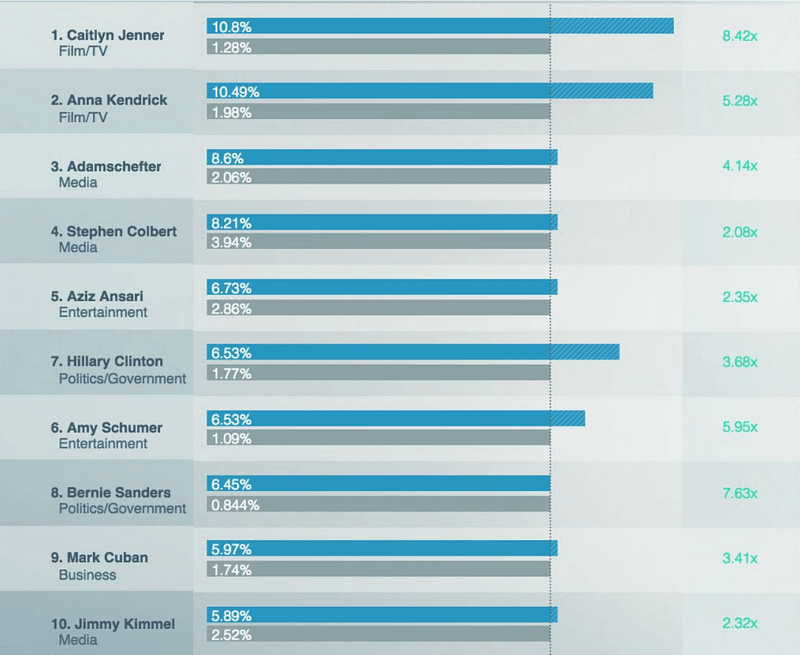
A leftward slant is detected, with the two Democrat presidential frontrunners on the list, a taste for comedy also seems apparent with Ms. Schumer, Mr. Colbert, and Mr. Ansari all accounted for.
TOP 10 SOCIAL INFLUENCERS AMONG THOSE DISCUSSING STARBUCKS ON SOCIAL MEDIA, BY PERCENTAGE
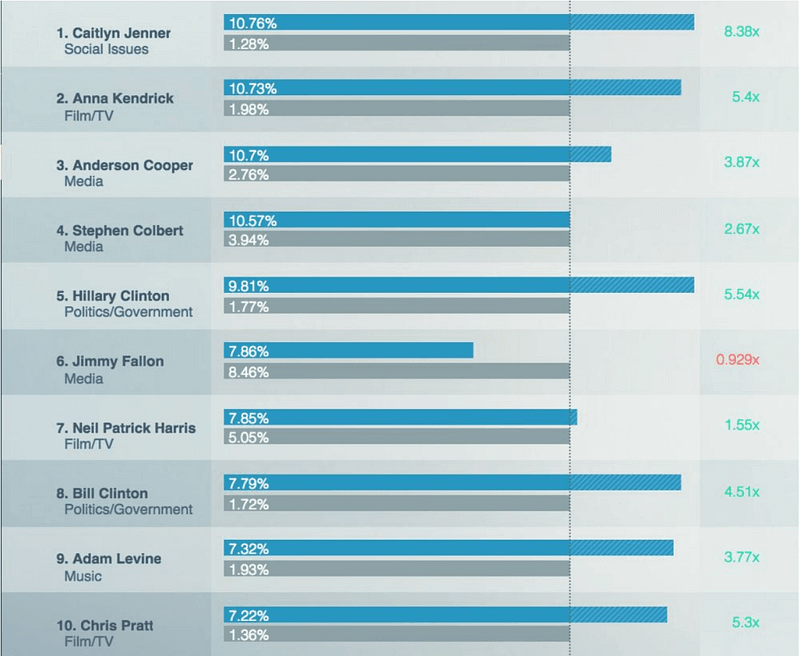
While she seems perfectly lovely, we never thought we’d describe Anna Kendrick as “ubiquitous” but as she and Ms. Jenner top both lists, I suppose she is pushing for ubiquity.
Again, a leftward — or shall we say progressive and/or tolerant — lean is evident, as both Clintons, two openly gay men (Mr. Cooper and Mr. Harris), and of course Ms. Jenner (who, it must be noted, is a Republican) are present. Colbert, to our knowledge, also isn’t that huge with those on the right, even since his move to network TV.
So, the audiences seem almost eerily similar regarded that way. Now let’s sort these lists by “multiple.”
Our one-of-a-kind “multiple” metric calculates — using the behavior of the average social media user as our baseline — the likelihood of a member of a specific social audience engaging in a certain behavior, liking or disliking something, being the member of another social audience, or nearly anything you can imagine.
When viewed through this lens the true heart of an audience can be revealed. While these lists above are telling, we’re dealing with social media figures with millions of followers. When you look at those social influencers who are uniquely appealing to a specific audience, you can often learn so much more.
(To see some studies where the perspective gained by the “multiple” metric was profound, check out our recent series of entries exploring and comparing the audiences of Shake Shack vs. Chick-fil-A .)
TOP 10 SOCIAL INFLUENCERS AMONG THOSE DISCUSSING DUNKIN DONUTS ON SOCIAL MEDIA, BY MULTIPLE
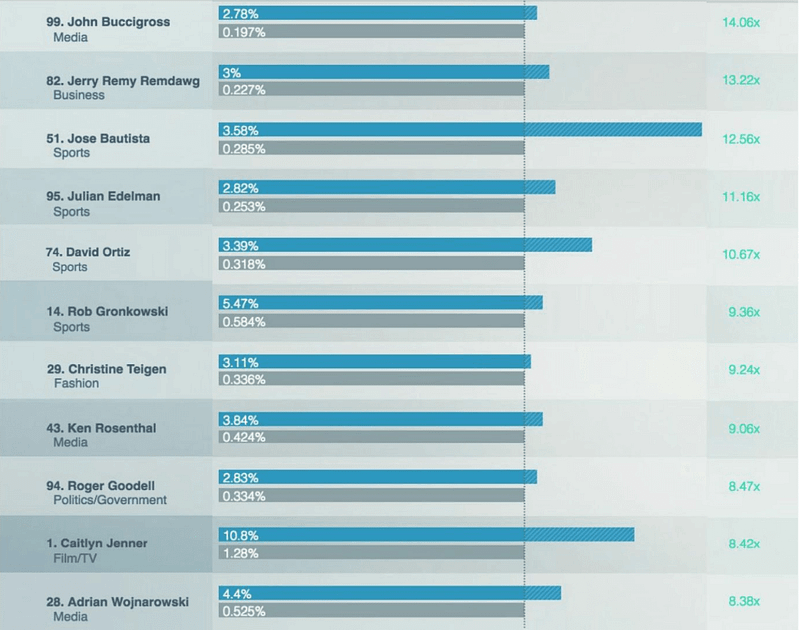
Okay — Suddenly things change quite a lot, and in a completely consistent way.
ESPN personality John Buccigross tops the list, followed by former baseball player, now Boston Red Sox announcer (for regional cable network NESN , or New England Sports Network ), Jerry “Remdawg” Remy.
From there it’s a grab bag, but a decidedly sports oriented one. Caitlyn Jenner is still there, but lest we forget she was an Olympic gold medal decathlete. Basically, it’s all columnists, announcers, active players, and one Sports Illustrated swimsuit model for good measure.
And here, ladies and gentlemen, is why we love the “multiple” metric. You can plainly see how immediately the narrative is changed as the heart of the audience has been revealed.
TOP 10 SOCIAL INFLUENCERS AMONG THOSE DISCUSSING STARBUCKS ON SOCIAL MEDIA, BY MULTIPLE
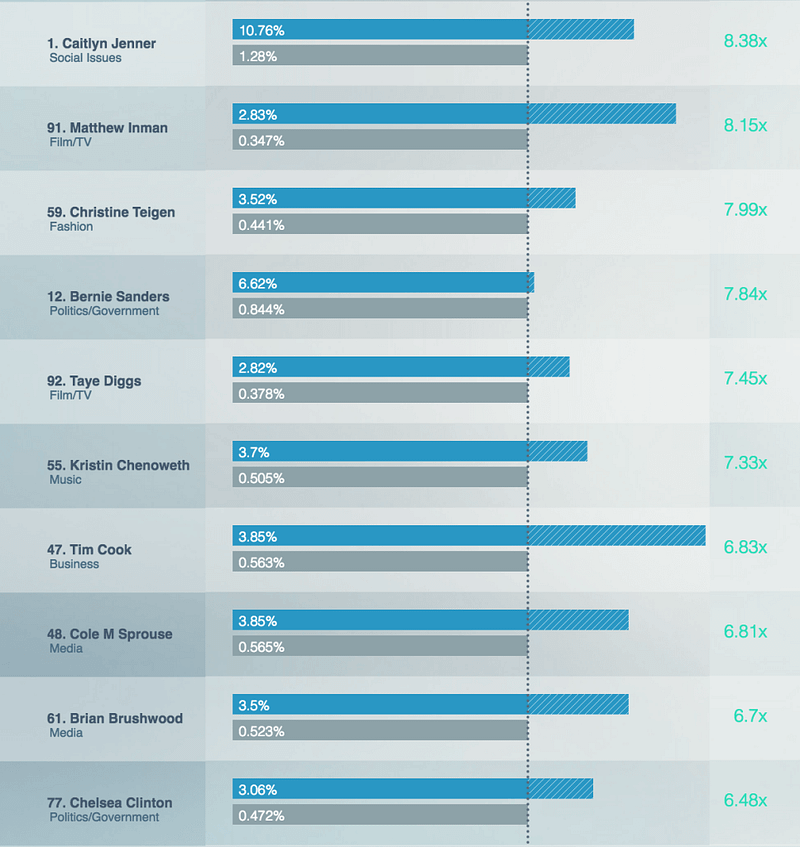
While surely a different list, this one reveals less of a surprise turn.
That too, of course, tells a story. It’s always a story.
Worth noting, a third, heretofore unseen Clinton suddenly appears, and we see that Ms. Jenner really is that popular with these groups.
We also see Apple CEO Tim Cook.
Mr. Cook’s presence makes perfect sense to any who have spent time inside of a Starbucks . Next time you’re at one, count the number of PCs you see being used among the many patrons on their laptops (it won’t take long). A count of Androids and Galaxys likely won’t take up too much more of your time.
Stay tuned, as in the next entry we turn to our partnership with IBM Watson and the Personality Insights ™ feature we’ve somewhat recently integrated into our reporting, to find out just how different these two audiences really are…
Or are they?
To learn much more about StatSocial , the curious are encouraged to visit the StatSocial site itself, where you’ll find all sorts of stuff including sample reports.
— -
If you like what you’ve read, please take a few minutes to watch this overview of StatSocial’s data: